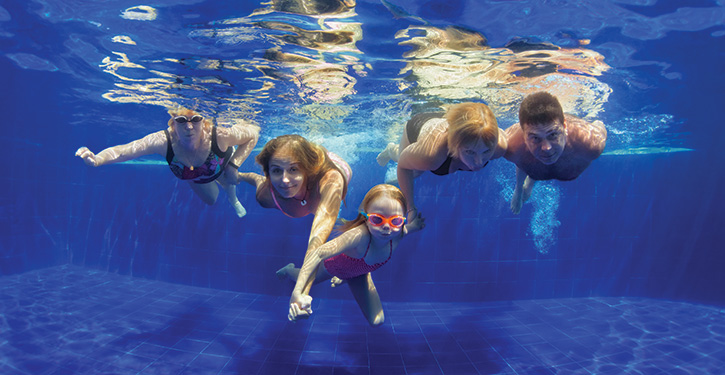Increasing student engagement offers numerous benefits to universities, including improved retention rates, a stronger sense of community and a higher likelihood of academic success. On many college campuses, aquatics amenities can be some of the most overlooked resources for engaging students. Often, pools are designed primarily for the swimming and diving teams, leaving little room for casual users. But with the right design elements and programming, pools can become dynamic spaces that foster community, wellness and student engagement.
Competition Pools: Built for All, Not Just Athletes
While athletic programs typically use competition pools, they can be thoughtfully adapted to engage the broader student body. Adding audio and video capabilities to the scoreboard system allows for dive-in movie events and campus advertising. The inclusion of color-changing capabilities in underwater lights supports nighttime “glow-swims,” while aquatics obstacle courses can be deployed during non-athletic hours.
Stainless-steel gutters can be incorporated to accommodate unique uses such as kayaking, canoeing and paddleboarding without the risk of breaking perimeter pool tiles. Movable floors or shallow zones can accommodate classic activities, such as pool volleyball or basketball. These additions don’t interfere with athletic performance, but they certainly help make the space more inviting to the general student population.
Recreation Pools: A Hub for Connection and Relaxation
Recreation pools are a powerful tool for promoting student engagement and should be seen as investments in student well-being. Modern rec pool designs prioritize flexibility and inclusivity. Shallow sun-shelves with loungers create a social, resort-like atmosphere. Beach entries offer both aesthetic and accessibility benefits, while spas provide a space for stress relief.
Large shallow zones up to four-feet deep encourage students to socialize and can also serve as spaces for fitness classes that either staff or students can program. Signature features like lazy rivers, waterslides, climbing walls or ziplines draw students in and help make the pool a standout campus amenity. If budget allows, custom tiling and color-coordinated deck equipment can help reinforce school branding and spirit.
It’s important to note recreation pool areas can extend beyond the water. Pool decks with seating, umbrellas and Wi-Fi create informal gathering or study spots, turning the pool into a vibrant social hub.
Promoting Aquatics Amenities: Market It and They Will Come
A well-designed pool is only effective if students are aware of its existence and feel welcome. Strong marketing is essential for maximizing usage and return on investment. Aquatics should be included in orientation tours and promoted at the start of the semester, when students are actively seeking ways to engage. Social media, campus signage and student-driven events can generate buzz and create lasting interest.
Through careful consideration during the design process, universities can transform their pools from underused athletic facilities into essential community spaces. With thoughtful planning and inclusive programming, aquatics amenities can become key contributors to student engagement, retention and overall well-being.
Cole Henry is the project director at Counsilman-Hunsaker. Learn more by visiting counsilmanhunsaker.com.










